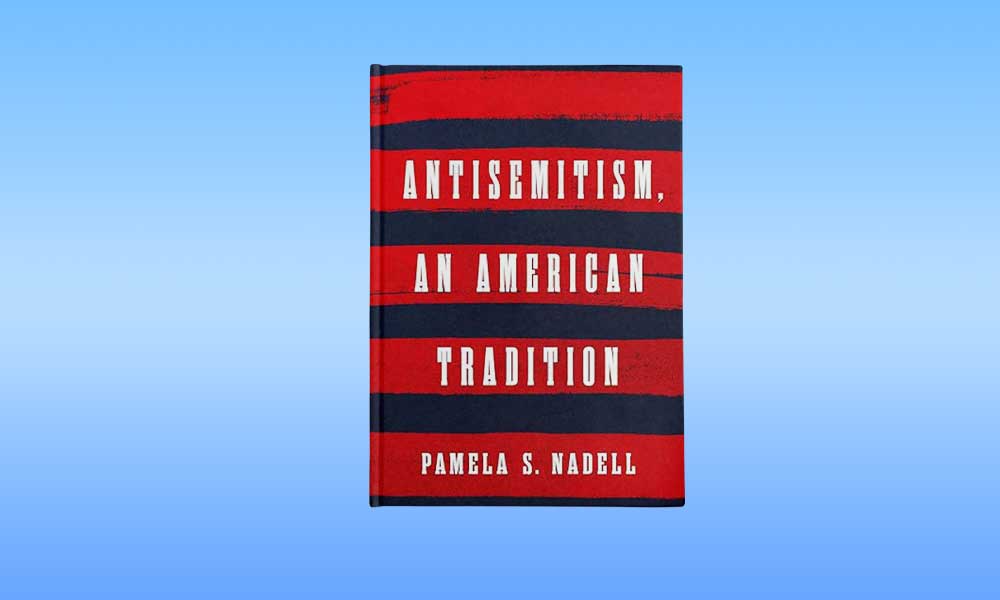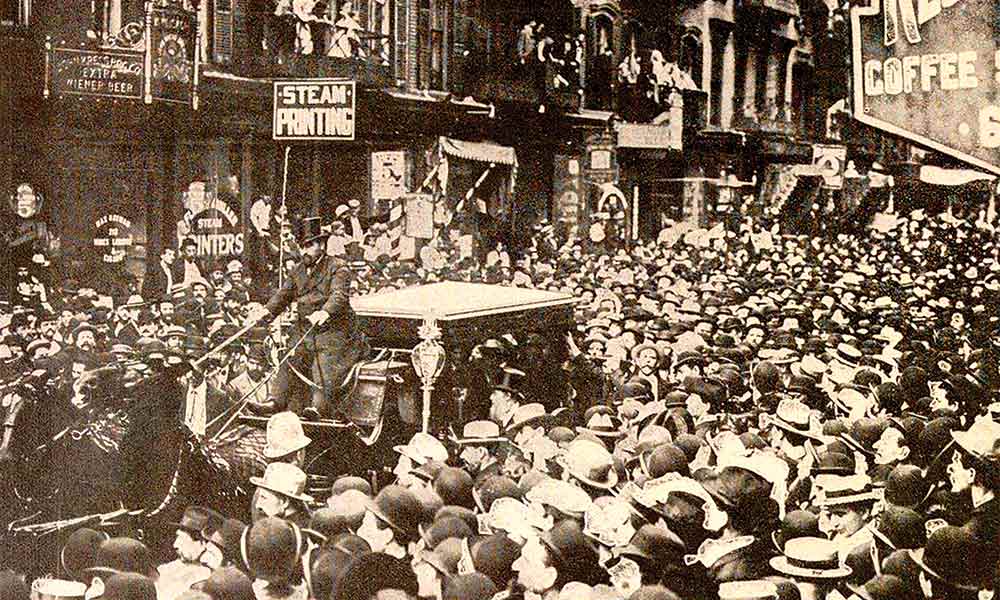
Antisemitism, an American Tradition
By Pamela S. Nadell
W.W. Norton, 352 pp.
On the afternoon of July 30, 1902, an estimated 20,000 to 30,000 Jews walked through the Lower East Side of Manhattan, following the funeral cortege of Rabbi Jacob Joseph, chief rabbi of the city’s Orthodox community. When they passed a certain factory whose workers were known to harass Jews in the neighborhood, those workers exhibited the abusive antisemitism for which they were feared. “They began pelting the crowd with melon rinds, scraps of steel, blocks of wood, iron bolts and bricks,” Pamela S. Nadell writes in her new history of antisemitism in America. “The street was so crowded that the Jews under attack could not escape.”
When the mourners tried to defend themselves by throwing bricks back through the factory’s windows at their tormentors, the factory’s owner called the police. Police Inspector Adam Cross “ordered the officers to ‘club the life out of the [Jews]’ and ‘kill them.’” In the next day’s New York Times, it was the lead story, including this line: “‘Is this Russia?’ shouted an old man, speaking with a foreign accent.” In fact, no one was killed, but hundreds of mourners were injured in what Nadell calls “the single largest antisemitic attack in U.S. history.”
What does it say about antisemitism in America that its most violent outrage is not widely remembered, caused no deaths and had some consequences that were arguably positive? Nadell observes that the perpetrators of violence against the Jewish mourners went unpunished.

1902 funeral procession for Rabbi Jacob Joseph.
True. But Scott Seligman, who wrote a book about the incident, The Chief Rabbi’s Funeral, found that some offending officers were transferred out of the Lower East Side, others took early retirement and the police commissioner was replaced. Seligman describes the incident as a moment that galvanized the leadership of New York City’s fractious Jewish communities, uptown Germans and downtown Russians, Reform and Orthodox alike, to unite in demanding the formation of a special citizens’ committee whose five members included two Jewish lawyers who were recognized national leaders, Louis Marshall and Nathan Bijur. The committee denounced misconduct by the police and created a model of Jewish organizations, through alliances with other reform-minded groups, denouncing and combating antisemitism—a model that survives today.
Did the riot that the Jewish Daily Forward called “a pogrom” demonstrate that life in America amounted only to Russia with a better job? Or did Jews enjoy benefits of American exceptionalism, antisemites notwithstanding, in a place fundamentally different from the countries they had left? In short, how bad was it here, and by extension, how bad is it today?
Coming at a time of increased antisemitic incidents both before and after the start of the Gaza War, Nadell’s book provides much useful context to the recurrence of antisemitic outrages throughout American history—though it would be enhanced by still more. The context it provides includes the history, from colonial times, of limitations on Jewish participation in a great variety of activities. To name just a few: holding public office on the state level (in states that chose to ignore the Constitution’s ban on a religious test for service); social exclusion, epitomized by the banker Joseph Seligman being refused a room at the Grand Union Hotel in Saratoga Springs, NY, in 1877; restrictive covenants on suburban homes; universities with quotas capping the number of Jews accepted; and professional schools doing their worst to keep their professions safely Protestant.
This is not news to people of a certain age, although it may have been forgotten by those young enough to grow up when antisemitism was decidedly out of fashion and the experiences of a more difficult time seemed long past. I was raised with the guidance that the State Department was no place for a Jew (my father no doubt was thinking of the antisemites at State who kept Jewish refugees out of the country during World War II). At my high school (named for the notoriously antisemitic governor of colonial New Amsterdam, Peter Stuyvesant), I knew that we benefited from an extraordinary generation of public school teachers in part because the doors to medical school had been barred to many Jews when they were young. There is enough there in our past to make one say of the present-day spike in antisemitism, “But of course.”
But there is a problem implicit in the act of focusing on the thread of antisemitism as a tradition of American life without the context of other traditions, some of them opposed to antisemitism and some philosemitic. In its history of antisemitic outrages—from New Amsterdam’s Stuyvesant trying to keep the Jews out, to colonial Boston preacher (and Harvard president) Increase Mather introducing the blood libel to the North American pulpit, to the lynching of Leo Frank and on to antisemitic abuses on contemporary campuses—the extraction of these events from a broader context could reasonably lead a newcomer to the subject to ask: Why did these Jews stay? Why didn’t they abandon such inhospitable surroundings for, say, a state created by and for Jews? The fact that Jews found pathways open to prosperity and political inclusion in the United States is no small matter.
Antisemitism in the old world explicitly barred Jews from many trades and professions and, until the 19th century, from citizenship. Both Christian Europe and Ottoman Turkey had traditions of national restrictions that applied specifically to Jews. In the Civil War, General Ulysses S. Grant notoriously barred Jews from the district of Tennessee liberated by the Union Army. But it is the one antisemitic dictum ever issued by the U.S. government. Grant’s biographer Ron Chernow describes how the carpetbagging Jews Grant had most in mind were his father’s business partners from Ohio, who were corruptly trying to use his entrée with the general to buy Southern cotton to fulfill their contract to produce Union Army uniforms. It should be added that President Abraham Lincoln, dependent though he was on Grant, overrode the order, calling it wrong to single out people of one faith. Grant’s otherwise adoring wife was among the many who criticized him for his action, and Grant went to his grave repentant for it. All of which is to say that Grant’s (uncharacteristic) singling out of a religious group ran counter to principles and traditions that many Americans held firmly.
Nadell frequently acknowledges in passing that restrictions that were placed on American Jews typically applied to Catholics, Blacks and other minorities as well. Without more than a recurring nod to the story of American anti-Catholicism, antisemitism appears to be sui generis rather than a feature of a Protestant nativism (which she does discuss) that targeted diverse victims. When Nadell cites an ad for a post-World War I housing development in Minneapolis that excludes “Chinese, Japanese, Moorish, Semites, and persons of ‘African blood or descent,’” I have to wonder whether the exclusion of Jews was less about what they were than what they were not.
Catholics, too, endured physical attacks, the enmity of groups like the Ku Klux Klan and the condemnation of their church by the spiritual descendants of Luther and Calvin as the “Whore of Babylon.” The Democratic Party Catholics often favored was derided as the party of “Rum, Romanism, and Rebellion.” The historian Arthur Schlesinger Jr. once described anti-Catholicism as “the deepest bias in the history of the American people.” Without more than a nod to the Catholic or, Lord knows, the Black experience, antisemitic discrimination risks appearing like a blemish on an otherwise racially and confessionally tolerant landscape.
Of course, Nadell’s mission is not a history of American minority groups, and her book is of a readable, less than encyclopedic length. The author once told me, very insightfully I thought, that in her research she had found that the idea of a Jewish Golden Age in Moorish Spain gained popularity around the time of the Dreyfus Affair: A loss of confidence in Western modernity led to a romanticization of the Jewish experience under medieval Islamic rule, an era that was, in fact, less than golden. I hope that the current bout of antisemitism does not retroactively cast the American Jewish experience as one defined by the country’s worst traditions and practices, rather than a mix of many traditions, some of them awful, most of them admirable.
Robert Siegel is Moment’s special literary contributor.
Moment Magazine participates in the Amazon Associates program and earns money from qualifying purchases.


